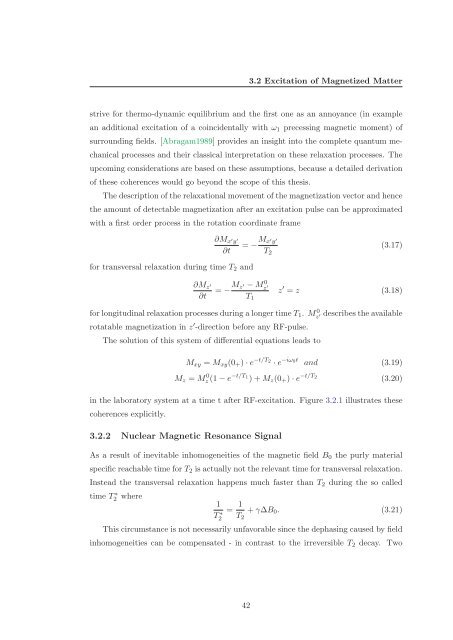Master's Thesis - Studierstube Augmented Reality Project - Graz ...
Master's Thesis - Studierstube Augmented Reality Project - Graz ...
Master's Thesis - Studierstube Augmented Reality Project - Graz ...
Create successful ePaper yourself
Turn your PDF publications into a flip-book with our unique Google optimized e-Paper software.
3.2 Excitation of Magnetized Matter<br />
strive for thermo-dynamic equilibrium and the first one as an annoyance (in example<br />
an additional excitation of a coincidentally with ω 1 precessing magnetic moment) of<br />
surrounding fields. [Abragam1989] provides an insight into the complete quantum mechanical<br />
processes and their classical interpretation on these relaxation processes. The<br />
upcoming considerations are based on these assumptions, because a detailed derivation<br />
of these coherences would go beyond the scope of this thesis.<br />
The description of the relaxational movement of the magnetization vector and hence<br />
the amount of detectable magnetization after an excitation pulse can be approximated<br />
with a first order process in the rotation coordinate frame<br />
∂M x ′ y ′<br />
∂t<br />
= − M x ′ y ′<br />
T 2<br />
(3.17)<br />
for transversal relaxation during time T 2 and<br />
∂M z ′<br />
∂t<br />
= − M z ′ − M 0 z ′<br />
T 1<br />
z ′ = z (3.18)<br />
for longitudinal relaxation processes during a longer time T 1 . M 0 z ′ describes the available<br />
rotatable magnetization in z ′ -direction before any RF-pulse.<br />
The solution of this system of differential equations leads to<br />
M xy = M xy (0 + ) · e −t/T2 · e −iω 0t<br />
and (3.19)<br />
M z = M 0 z (1 − e −t/T 1<br />
) + M z (0 + ) · e −t/T 2<br />
(3.20)<br />
in the laboratory system at a time t after RF-excitation. Figure 3.2.1 illustrates these<br />
coherences explicitly.<br />
3.2.2 Nuclear Magnetic Resonance Signal<br />
As a result of inevitable inhomogeneities of the magnetic field B 0 the purly material<br />
specific reachable time for T 2 is actually not the relevant time for transversal relaxation.<br />
Instead the transversal relaxation happens much faster than T 2 during the so called<br />
time T ∗ 2 where 1<br />
T ∗ 2<br />
= 1 T 2<br />
+ γ∆B 0 . (3.21)<br />
This circumstance is not necessarily unfavorable since the dephasing caused by field<br />
inhomogeneities can be compensated - in contrast to the irreversible T 2 decay. Two<br />
42





